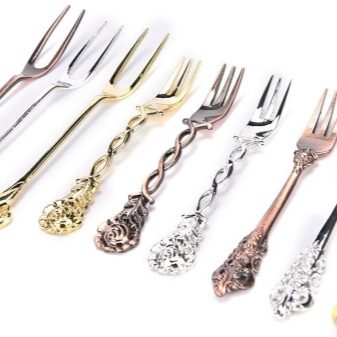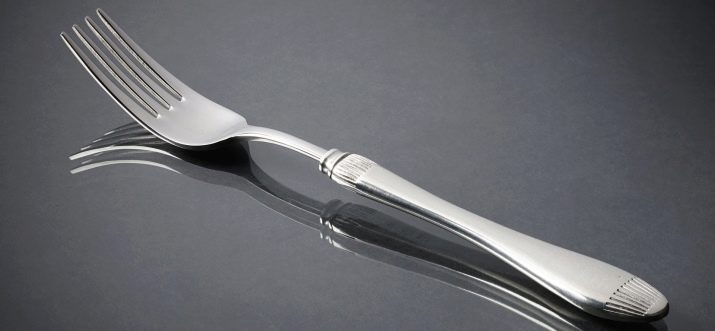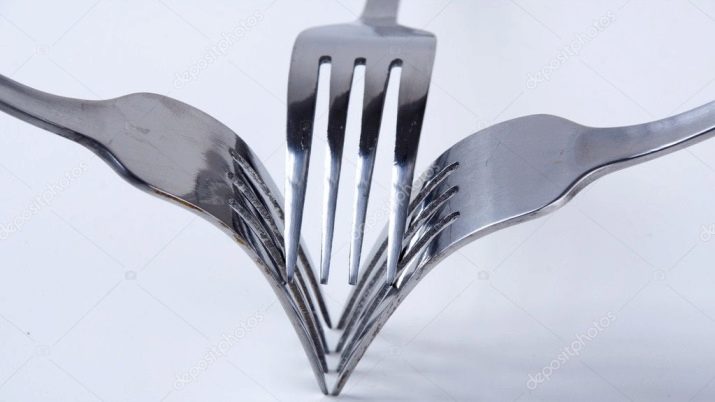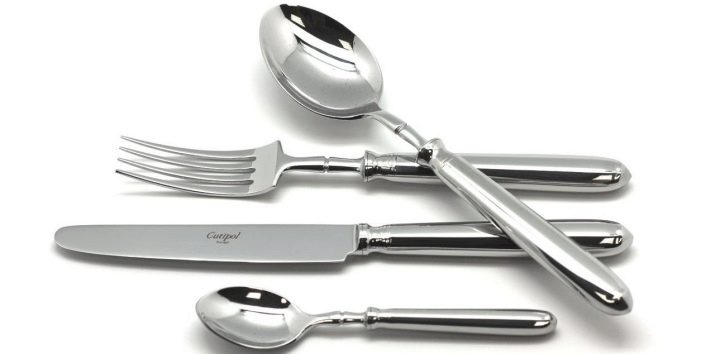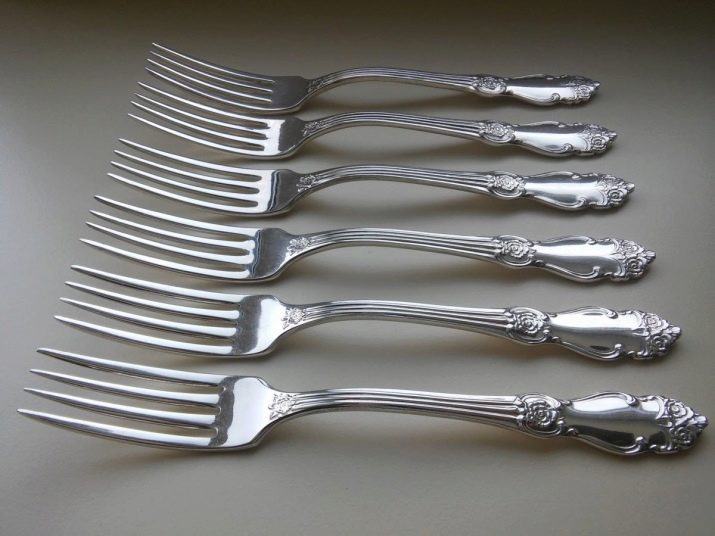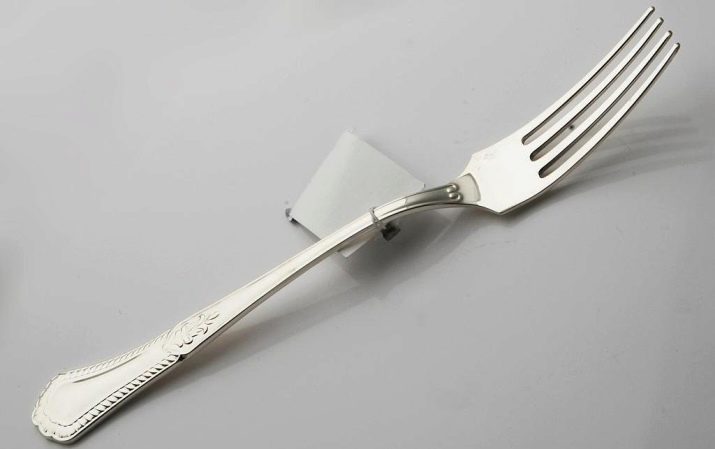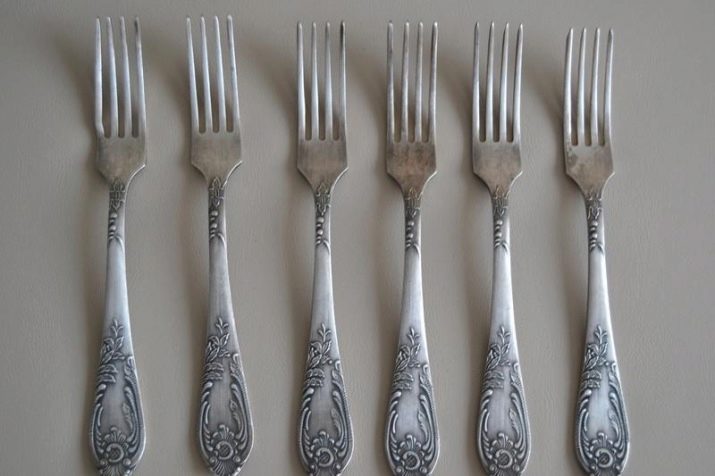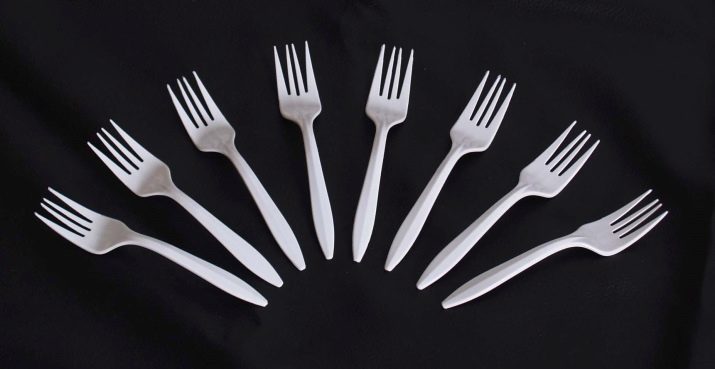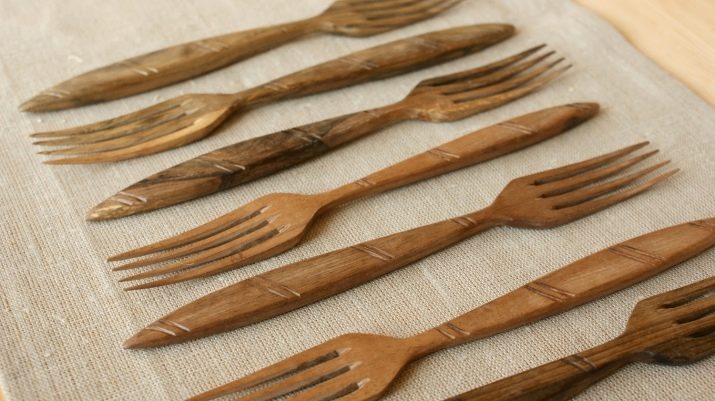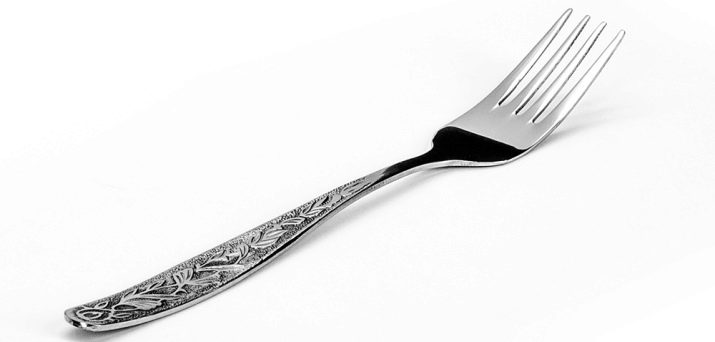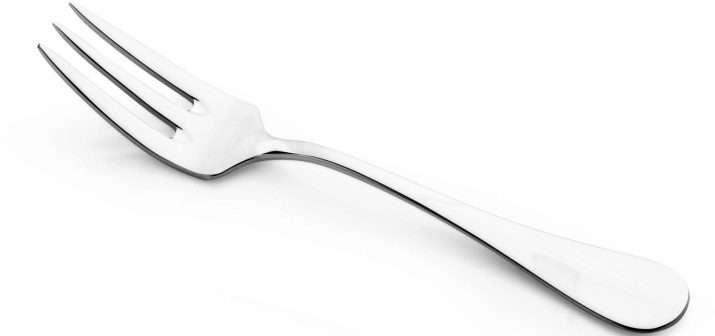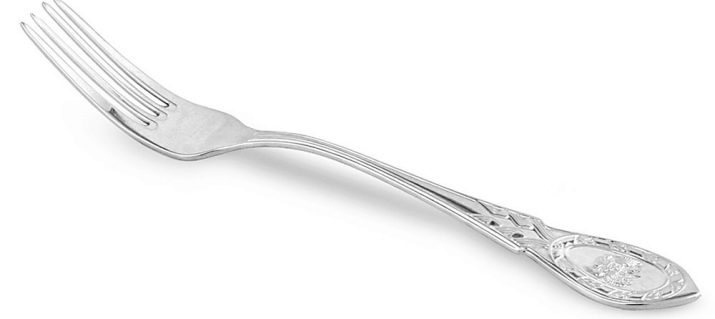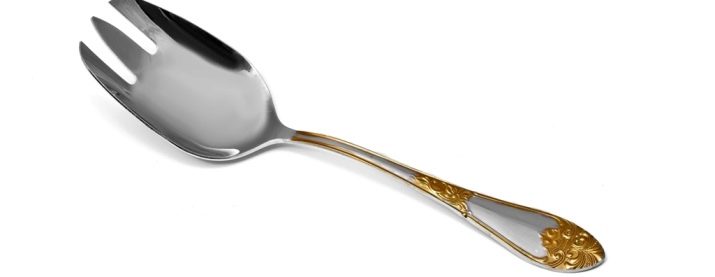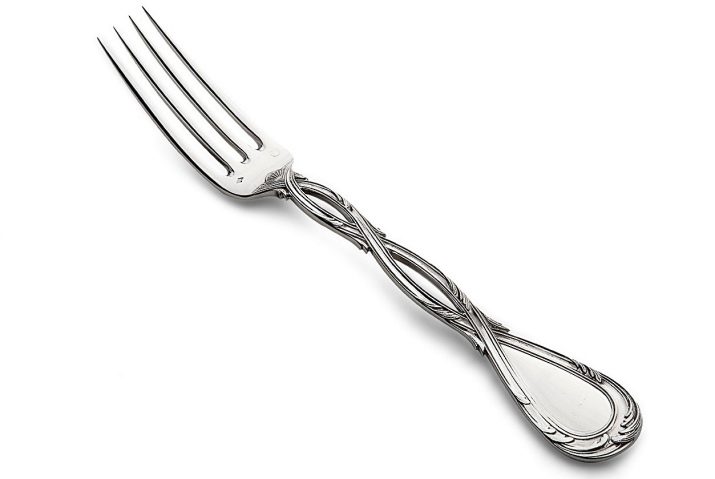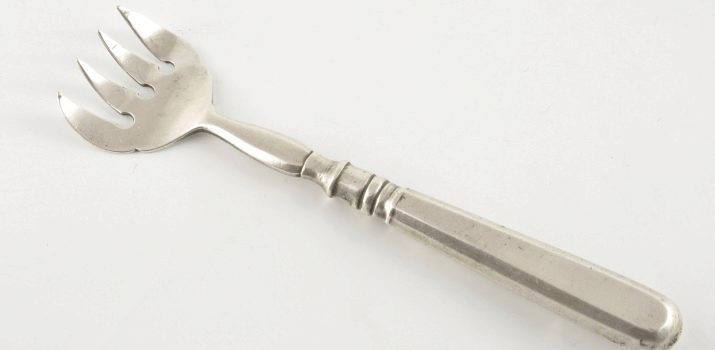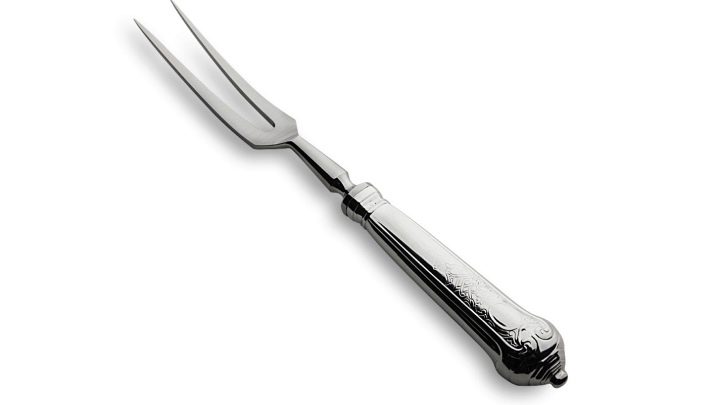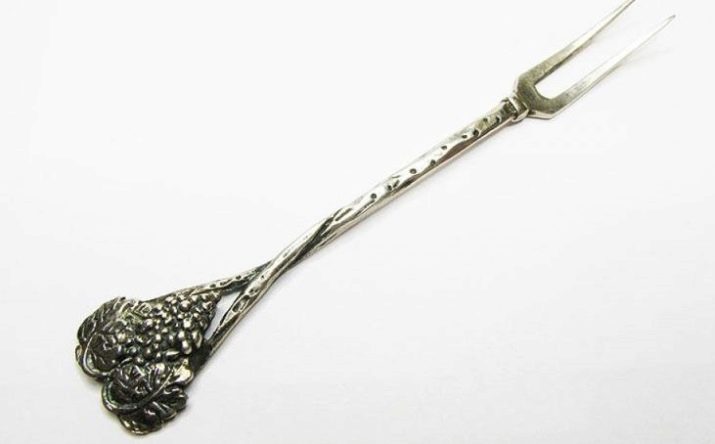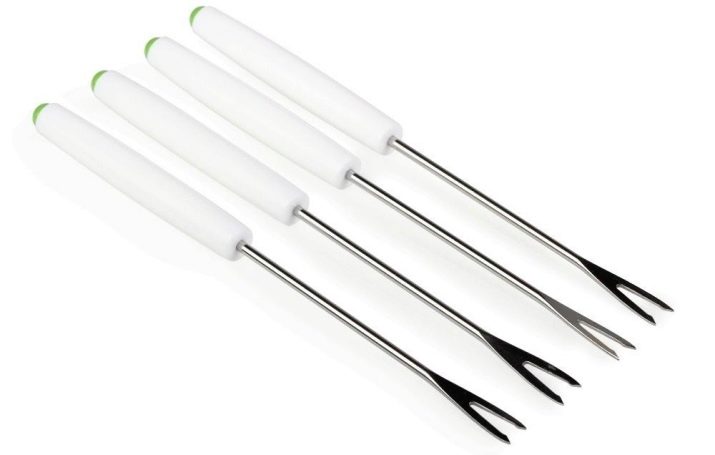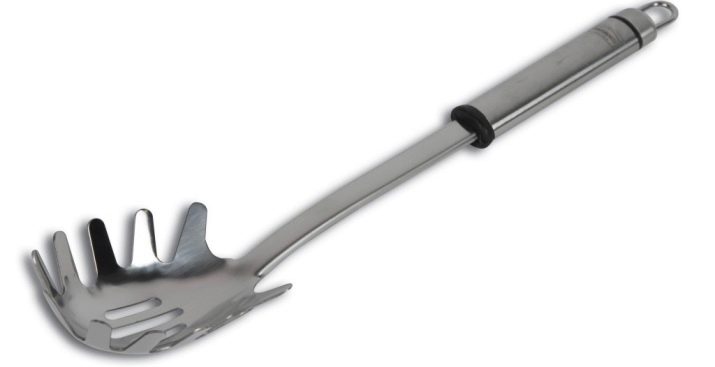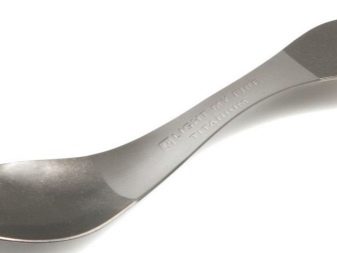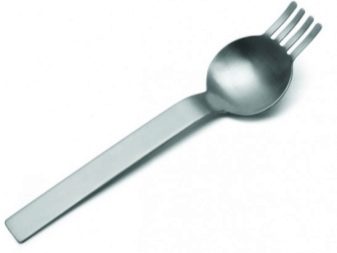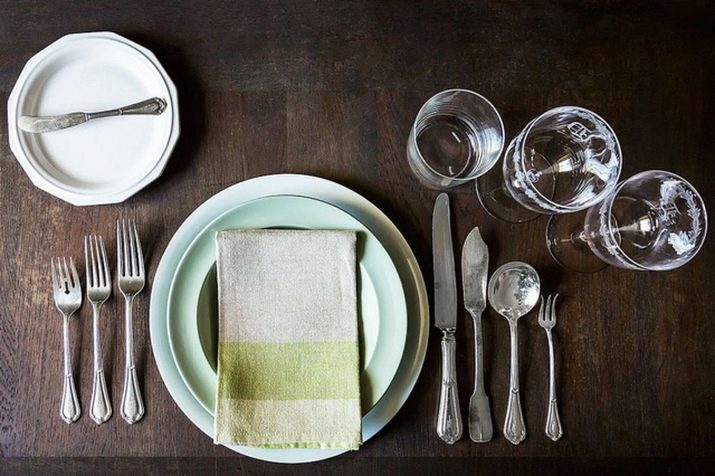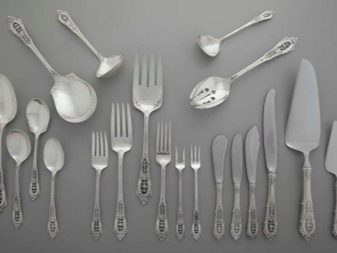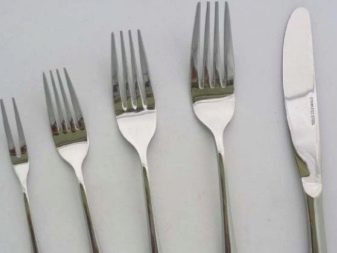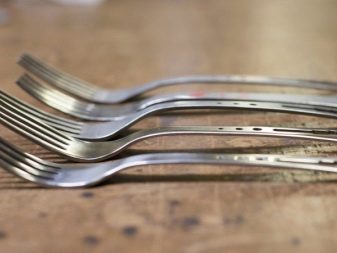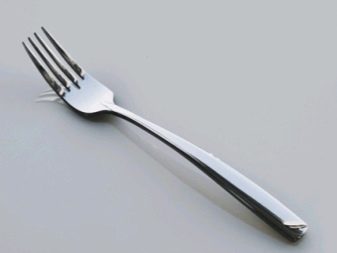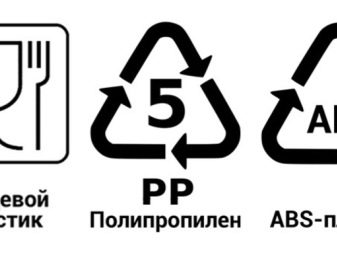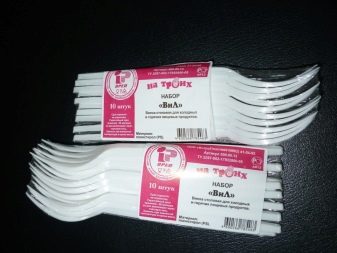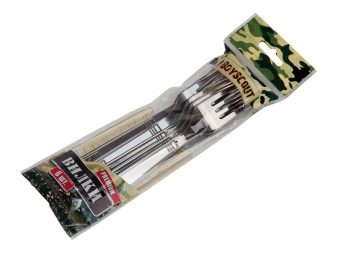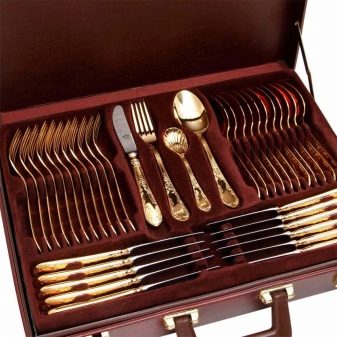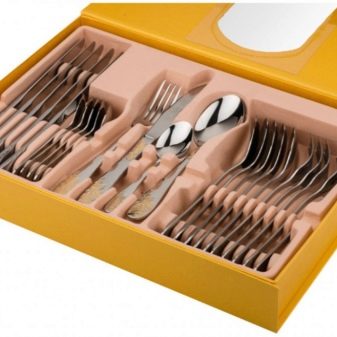This cutlery begins its history in the XV century. Initially, he had 2 teeth, was flat and very uncomfortable to use. However, over time, the device was modified until it acquired the look of a modern plug.
Manufacturing materials
Duration of operation, appearance and strength of forks depend on the materials from which they are made, as well as on the selected production technology. In most cases, stainless steel is used as the base, and chrome is used as the top layer. The more dense the chromed layer is, the higher the resistance of the device to the effects of corrosion.
Another "running" material - steel with the addition of nickel. In premium devices, silver and gold are used as the top layer.
Consider the most popular options.
Steel
Steel cutlery by itself cannot exist; it will be unstable to corrosion. In this regard, steel forks can be produced in the following versions.
Chrome steel forks
The composition of the material is usually steel, iron and carbon, as well as a small (13-17%) chromium. It is made of steel 18C, sometimes it is labeled as 18/0. Such steel belongs to the class AISI 430 and is considered budgetary. As a rule, such devices are said to be stainless steel.
Chrome products can be recognized by the noble metallic luster, which significantly increases the aesthetic appeal of the devices. In addition to attractiveness, chrome-plated devices are resistant to corrosion, do not absorb odors and colors. Due to its high magnetic properties, these forks are widely used in catering establishments. This is due to the fact that they have widespread equipment for washing dishes with magnetic systems.
Steel appliances with chrome and nickel in the composition.
Material includes steel, carbon, iron, not more than 18% chromium and 8.5-10% nickel. This composition is considered one of the highest quality, Nickel chrome steel is assigned a grade of 18/10, also labeled AISI 304. Nickel-chrome instruments, due to their special treatment, have a pleasant creamy shade. Thanks to chromium in the composition of the plug, they possess enhanced anti-corrosion properties, while nickel provides increased resistance of the devices to acids (including concentrated ones).
Chrome-nickel with silver plating
The devices are a nickel-nickel analogue, on which silver is applied in one layer. The latter undergoes a special cleaning, after which reinforcing elements are added to this composition. Silver-coated kits are often accompanied by the inscription "90-gram silver." It means that 90 g of silver are applied to a set of 12 devices. Such products are resistant to corrosion, they can be washed in a “dishwasher”.
Silver
There are 2 types: from silver 800 tests and 925 tests. The first ones contain 800 parts of silver and 200 g of another metal. Forks of 925 samples are composed of 925 parts of silver and a total of 75 parts of another metal. On their surface a sample is necessarily indicated, and there is also a crown symbol.
Devices from pure silver usually act as gift, decorative. For everyday use, they are suitable little - too heavy, prone to corrosion.
Gold plated
These are already well-known products from steel or stainless steel, covered with a thin layer of gold. Gold plating is so thin that it is measured in microns (1 micron - 0.001 mm).Gilding can cover the entire device or only a certain part of it.
Aluminum
These forks are well known for Soviet canteens. They were very fragile - they bent easily, it was almost impossible to pick up meat or another dense piece of food with teeth. The disadvantages are attributed and nondescript appearance. No wonder that Aluminum devices today have practically disappeared from use and sale.
Melchior
Melchior plugs are classified as luxury appliances. The material is an alloy of copper, nickel and manganese. Such products look very elegant, noble, resistant to corrosion, but their production is quite expensive. Since the 1950s, nickel silver has increasingly been replaced by German silver. In appearance, the devices are almost indistinguishable, however, the production process in the latter case is somewhat simplified.
Nelsiber is an alloy of copper, nickel and zinc. The surface of such products is necessarily covered with a layer of gold or silver or blackened.
Plastic
In most cases, the plastic plug is the right “companion” of picnics and attacks on nature. Such devices can be disposable (only these should be used in fast food cafes, fast food outlets and other public places) and reusable (usually more durable, can be washed by hand in warm water and used several times).
Tree
Wooden spoons and forks today, rather, decorative elements of the interior, rather than practical cutlery. The explanation for this is the fragility of products, their ability to absorb moisture, fats, and odors. Such devices are very difficult to clean, and therefore their lifespan is very small. If a wooden plug is coated with varnish, then it is impossible to speak with confidence about its safety, if it is not covered - the question arises about the hygiene of the product.
It is worth noting that quite often manufacturers produce forks of composite materials. It can be stainless steel or nickel chrome combined with wooden or plastic handles. Melkhiorovye devices are often supplemented with gold or silver plating.
Species by appointment
Depending on the purpose, the following types of plugs are distinguished.
Dining
It is a device with four teeth. Appointment - the use of second courses, because dinner forks are most often served with a table knife. In this case, the knife is taken in the right hand, the fork - in the left. You can cut a piece of meat by sticking the last one into the food and cutting off the piece with a knife. If they eat the second with a fork, they keep it tine up as a spoon. Food is “planted” on it, if necessary helping itself with a knife.
The size of the dinner fork is usually comparable to the size of the serving plate. The device is placed on the table on the left; if the table is served with several forks at once, then the dining room will be the largest and lie closest to the plate.
For fish
This device is slightly smaller than the analogue of the dinner, has 3 and 4 teeth, they are shorter than the teeth of the dining fork. Sometimes the teeth are arranged in pairs and in the middle are separated by a shallow recess. The device for fish is served with a special fish knife. The latter can replace another fish fork.
With a second fork or knife, a piece of fish is pressed against the plate, while small pieces are separated from the other piece. After this part of the fish is eaten, it is turned over and similarly “cracked down” with the second side. Ideally, after a meal, only the fish skeleton should remain on the plate.
According to the rules of modern etiquette serves either 2 fish forks, or a fork and a special spatula. The fish knife is usually served only with herring.
Snack Bar
It is intended for the use of cold appetizers, omelettes, spring rolls, fried bacon. Externally, it is a copy of a dining appliance, but much smaller.
If several forks are placed next to the plate, the eatery is third after lunch and fish.
Salad
Designed for salads, has 4 teeth and a wider base. It is more curved in the manner of a spoon. Usually served with a special salad knife. It is used in the same way as the dining room. Large pieces puncture the fork, if necessary, cut with a knife into smaller pieces.
If there is a chopped salad in front of you, the fork is turned upside down and the food is scooped into it like a spoon.
Dessert
Differs in the smallest size, has 2 or 3 shortened teeth. For fruit always serves two teeth. Cakes, pies and small cakes require different types of dessert forks, in some cases they are served with a dessert knife. On desserts for special desserts they serve a special device with a pointed clove. It is used as a knife, while the rest of the teeth are punctured into pieces. Buffet fork is a necessary necessity, because it is impossible to use a knife on a buffet table.
However, if there is an opportunity to put a plate on the table, the buffet fork should be abandoned, using a dessert analog and a knife instead.
For asparagus beans
It is used for transferring dishes from a common plate to its own. It is a device from a single piece of metal, which is then divided into 2 cloves, representing the letter U.
Chopping
It is larger than the dining room. And besides, the finishing device is more elongated. Used for cutting a common piece of meat into plates or slices. Meat is strung on a fork and cut with a special cutting knife.
Fatty, or cook
The device with two horns and a long handle, which is used mainly in the kitchen for cooking, turn over the pieces, check readiness, cut a large piece into smaller ones. This fork is convenient to get the meat from the broth and chop it. In this case, a large tranzgirnaya fork is useful, between which there is a hinged stop between the handle and the teeth.
Sprat
This fork is distinguished by the presence of 5 teeth and a wider base. This allows you to bring sprats to the mouth without losing the integrity and aesthetic appearance of the fish.
For seafood and oysters
It is a slightly elongated device with 3 teeth, the left one is slightly longer than the others. It is convenient for them to eat seafood, as well as open oyster shells and reach mollusks. She can also eat mussels, cocktails. A fork is served with a coffee spoon, which is customary to eat a seafood cocktail.
For lobster table served with a fork with 2 bent teeth. The dimensions of the instruments for seafood are small. But the fork for crayfish has a more elongated shape and a long handle. This is a 2 prong device. The device for crabs may be the same.
Olive
A small (less dessert) fork with 2 teeth to grip the olives. A similar design has a fork for lemon, but it is larger in size than the olive one.
Kokotnaya
The device, which is served to the julienne, has 3 cloves, while the lateral are somewhat divorced to the side. The fork itself is small, comparable in size to a dessert spoon.
For fondue
The device with 2 teeth on a long handle.
For spaghetti
The invention of Japanese experts, designed specifically for easy eating spaghetti and noodles. It is a gear device with an additional shorter tooth for gripping food and barbs on the surface to hold pasta.
Sporf
Device "3 in 1", combining fork, spoon and knife. Invented in the 40s in Austria, initially called the plaid. Today it is produced by the only company in the world and is produced in Austria.
Another similar multifunctional device is the Spork. It is both a fork and a knife. Invented and patented in the USA at the end of the XIX century. Only in the XX century the device received the specified name. Such devices are convenient in terms of travel and hiking. Foldable fork and fork-knife for canned food - from the same "company".
For pizza
Appeared recently, only in 2007, the device. Combines a round pizza cutter and a dining fork.
It is fair to note that, of all the varieties described, most often only 4 types of forks are involved in serving - lunch, salad, fish and dessert. As a rule, the meal begins with the supply of salads, snacks. They are served with a set of salad forks and knives. In addition to salads, they can be used for snacks (not sandwiches, they are taken by hand), aspic, various meats.
Then, when giving hot, the set of devices is replaced by a fork and a knife for the second. If fish is served on the hot, then an additional table is served with fish appliances.
At the end of the meal, pastries, desserts and fruits are served, to which special appliances are also put on the table.
How to choose?
Before buying devices worth paying for the material from which they are made. Another factor is the thickness of the metal. A quality product has a metal part thickness of at least 2.5 mm. The standard is considered to be the thickness from 1.4 to 4 mm.
Appreciate the shine of forks - grayish or white. If the lack of gloss is not provided by the design of products, then this indicates a low quality of steel or the absence of at least some polishing devices.
One of the most labor-intensive manufacturing processes is the processing of fork teeth, so unscrupulous vendors sometimes make them cut off. A quality product cannot have this, as well as overly sharp teeth.
The next selection criterion is the characteristic of the bends of the forks. At this point there should be a thicker layer of metal so that the fork does not bend if it is pressed more than usual. The depth of a quality device should be at least 7-10 mm. Flatter products are Chinese stamping, which is inconvenient to use.
It is important to carefully touch the surface of the product - it should be smooth, without roughness and chipping, uniform, not have stains and stains. Only in this case, we can talk about the accuracy of processing. In high-quality devices, only the tip of the teeth can be sharp.
When buying a combined instrument, inspect the junction of different materials - whether there are no joints and offsets. The forks must fit tightly in plastic or wooden handles. If the latter are made of plastic, it must be heat and moisture resistant.
If you are looking for appliances for everyday use at an affordable price, give preference to stainless steel plugs. This is the optimal balance of quality and cost. The choice should be made in favor of all-metal options.
Separately it is necessary to say about disposable plastic forks. The main selection criteria are safety and heat resistance (within the scope of the material, of course). You can understand how harmless plastic is by labeling. Without fear, you can purchase forks, which means the following.
- RE (PE)that is, polyethylene.
- PETF (PET) or PET (PET) - indication of polyethylene terephthalate.
- PS (PS) or the number "6" - polystyrene. Fork (or any plastic disposable tableware) is suitable only for cold dishes. There is hot food and the more heat the dishes in the microwave can not.
- PP (PP, number 5) - polypropylene. Suitable for hot dishes, can withstand heat up to 100 degrees. Contact of polypropylene with alcohol is unacceptable, otherwise toxins are emitted from such contact.
If you plan to wash the forks in the dishwasher, make sure that the requirements for the use of cutlery comply with the technical features of the dishwasher.
After visual inspection, sniff the instruments. They should not have a smell. But the pronounced aroma of engine oil, metal - a significant reason to abandon the purchase. Finally, should ask the seller for a certificate of conformity and hygienic conclusion. The name of the brand of devices, their manufacturer and its address in these documents must coincide with the data indicated on the package of forks.
As a rule, forks are sold complete with other appliances necessary for serving (spoons, knives). Kits are for 6 and 12 people.The first includes 24 items - 6 tablespoons and teaspoons, 6 forks and knives.
A set for 12 persons includes the same devices, but already for 12 people, as well as spoons for jam and sauce, for sugar, forks and knives for fish and salad - only 72 items.
In addition, there are options in which only forks and knives are included, as well as different types of forks and spatulas / knives for them.
To learn how to properly use cutlery, see the following video.



